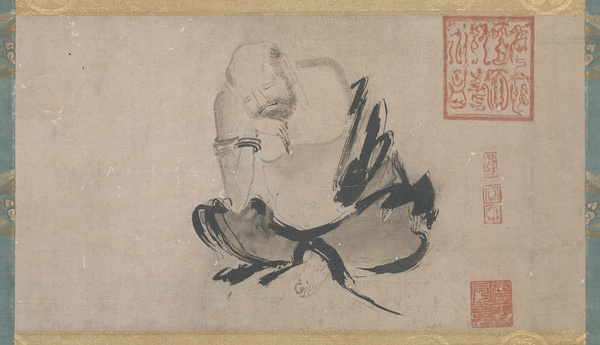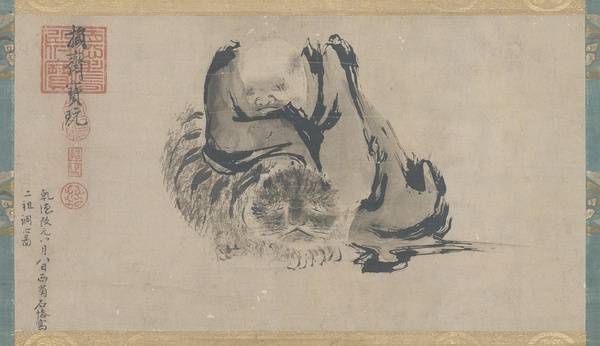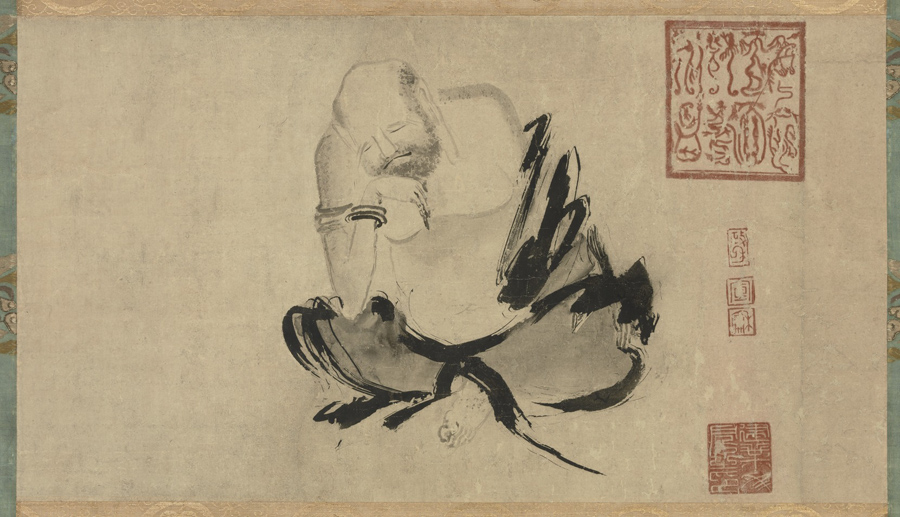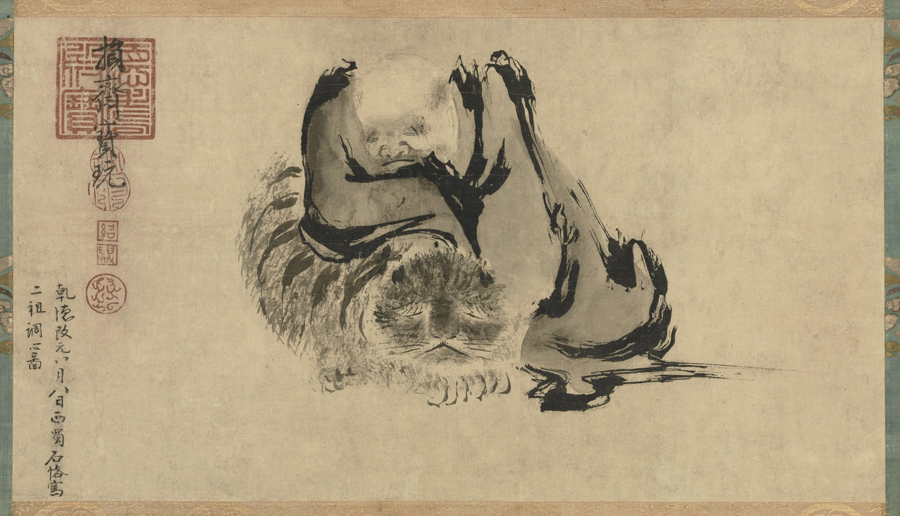ZEN MESTEREK ZEN MASTERS
« Zen főoldal
« vissza a Terebess Online nyitólapjára


二祖調心圖 “èr zǔ diào xīn tú”
The Second Patriarch (慧可 Huike) in Contemplation
(Rōmaji:) 二祖調心図 Niso chōshin zu


二祖調心図
Two Patriarchs with Minds in Harmony
Two hanging scrolls, ink on paper, 35.3 x 64.4 cm, Tokyo National Museum
This work is attributed to Shi Ke of the Hou (later) Shu kingdom in the period of Five Dynasties. He studied under Zhang Nanben ( 張南本), who was a master at painting fire, and was good at figure painting. Although he did not care what other people think and pursued his own free style with ease, Shi Ke's painting style, where faces are painted in details while clothes are drawn with simple strokes became the standard for subsequent figure painting in China. The second Zen patriarch in contemplation is the work that best represents Shi Ke's paintings expressed using only lines and shades.
http://www.chinaonlinemuseum.com/painting-shi-ke-second-patriarch.php
Two Chan Patriarchs Harmonizing their Minds
Niso chōshin
In the style of Shi Ke (died after 975),
probably 13th century.
Pair of hanging scrolls. Ink on paper.
35.4 x 64.3 cm each.
Tokyo National Museum.
Important Cultural Property, Jūyō Bunkazai.
The two paintings, now mounted as hanging
scrolls, were originally parts of a handscroll
bearing a colophon by the Yuan literatus
Yu Ji. The two old patriarchs in
deep meditation are rendered in a highly
unconventional style using bold, rough
lines applied by a coarse brush and broad,
grey washes. The bald-headed masters of
meditation are seated - collapsed, really -
in frontal posture with their eyes closed.
The patriarch on the right scroll leans his
chin on the back of his right hand; the
elbow of the right arm rests on the right
knee. The robe has slipped down from the
shoulders, baring most of the torso; the
left arm, however, remains hidden under
the agitated folds of the garment. The
patriarch of the left painting leans comfortably
on the neck of a tiger slumbering
at his side. The soft fur of the tiger is
dabbed on to the paper with a rough, dry
brush, and strikingly characterized by
somewhat wetter, black stripes. The
peaceful companionship of monk and
tiger in meditative immersion conveys fundamental
Buddhist ideas about man and
nature.On the left edge, the scroll with the tiger
has a signature which reads: "On the
eighth day of the eighth month in the first
year of Qiande [era, 963], Shi Ke from
western Shu [Sichuan] painted the images
of the two patriarchs harmonizing their
minds." In addition, there are Imperial
seals such as the one of the art-loving last
Northern Song Emperor Huizong with the
reign titles Zhenghe (1111-1118) and
Xuanhe (1119-1125), as well as one of the
Southern Song Emperor Gaozong with
the reign title Shaoxing (1131-1162). However,
the two paintings are certainly not
originals by Shi Ke dating to the tenth century,
but faithful copies probably dating to
the end of the Southern Song or the
beginning of the Yuan Dynasty.
One of Shi Ke's names is Zizhuan. He
hailed from Shu in western China, modern
Sichuan Province. After the Song had
conquered Shu in 965, Shi Ke moved to
the new capital Bianjing, modern Kaifeng
in Henan Province. There he earned fame
and great esteem: the Imperial court commissioned
wall paintings from him for the
restoration of the Xiangguosi, one of the
most important metropolitan monasteries,
and offered him a post at the Imperial
painting academy, the huayuan. However,
Shi Ke declined the offer and asked for
permission to return to his home province.
He died on the way back to Shu.Traditional sources tell us that Shi Ke's
painting belonged to an unconventional
school of monochrome ink painting, practised
in spontaneous, untrammeled freedom
by eccentric artists, yipin, since the
middle of the Tang Dynasty. Face, hands,
and feet of figures were painted with fine
brushstrokes. For the garments, however,
a rough, sometimes even wild, brush
technique was used. The copies at the
Tokyo National Museum showing the two
patriarchs are representative examples of
this style.Zen - masters of meditation in images and writings
by Helmut Brinker [1939–2012]; Hiroshi Kanazawa [金沢 比呂司 1937-]
Museum Rietberg; Artibus Asiae, Zürich, 1996, 218 p.
Shi Ke ou Che K'o ou Shih K'o, surnom: 子专 Zizhuan est un peintre chinois du Xe siècle, originaire de Chengdu (capitale de la province du Sichuan). Ses dates de naissance et de décès ne sont pas connues.
Biographie
On connait mal la vie de cet artiste, soi-disant adepte du chan, dont reste légendaire, l'extravagance. Un texte de la première moitié du Xe siècle relate qu'il aime bien choquer les gens, qu'il représente surtout des bonshommes âpres et rustiques et que son souffle est résolu et vigoureux. d'après un autre ouvrage, il ne tient aucun compte des règles et des modèles et ses peintures sont hideusement bizarres, c'est-à-dire indignes de gens civilisés; on peut noter qu'en raison de ce jugement de lettré, ses œuvres, ou du moins leurs copies, passent très tôt au Japon où elles sont fort appréciées. Selon le Xuanhe Huapu (Catalogue des collections impériales Song, il est appelé, en 965, pour décorer les murs du temple Xiangguo-si, à la capitale Kaifeng. On lui offre à cette occasion un poste à l'Académie Impériale de Peinture, mais il décline l'invitation et, décidant de regagner son pays natal, meurt sur le chemin du retour. Connu comme peintre de figures bouddhistes et taoïstes, il peut être l'un des plus importants tenants de la peinture monochrome à l'encre, dans le style yipin, sans contraintes, que l'on associe souvent à l'art chan. On lui attribue deux œuvres, conservées au Musée National de Tokyo Deux patriarches en train de mettre leur esprit en harmonie, probablement des copies assez fidèles mais qui ne remontent sûrement pas à l'époque des Cinq Dynasties. Quelle que soit leur véritable ancienneté, elles sont un précieux témoin du graphisme rêche de la manière yipin appliqué à la peinture de personnages, et là se trouve leur importance.La vie artistique au pays de Shu
Parmi les dix royaumes qui se constituent au Xe siècle, celui des Tang du Sud (Nankin) est, avec celui de Shu (Sichuan), le plus brillant. Dans ces deux royaumes, les traditions des Tang trouvent refuge et, à la cour de Li Yu, comme à celle du Shu, on voit se créer des académies de peinture. L'influence du chan est alors dominante. Parmi les peintres « hors catégorie » de ce moment, Shi Ke est l'un de ceux qui exprime le mieux la totale liberté en rejettant tout geste d'appui, et restant « sans affaires ». Originaire de Chengdu, il est d'humeur indépendante et railleuse. Il reçoit une éducation classique, mais sa vocation profonde est la peinture. Il peint d'abord des sujets traditionnels, puis il s'émancipe de toutes contraintes et se met à travailler avec audace et liberté, insoucieux des règles et des modèles. Il ressent une certaine satisfaction à enlaidir étrangement ses figures. Actuellement ne lui sont attribuées que deux sections d'un rouleau de peinture représentant deux patriarches.http://fr.wikipedia.org/wiki/Shi_Ke